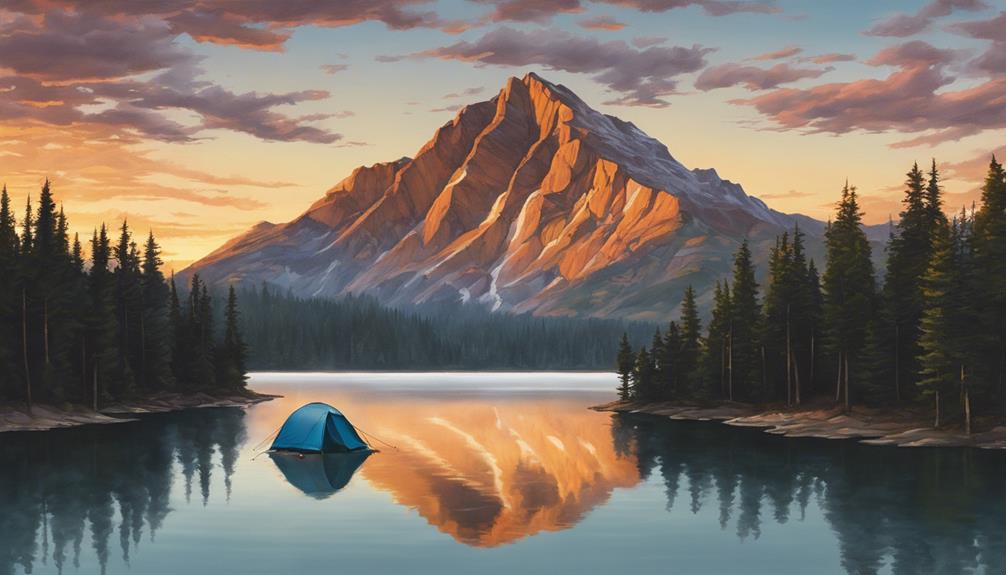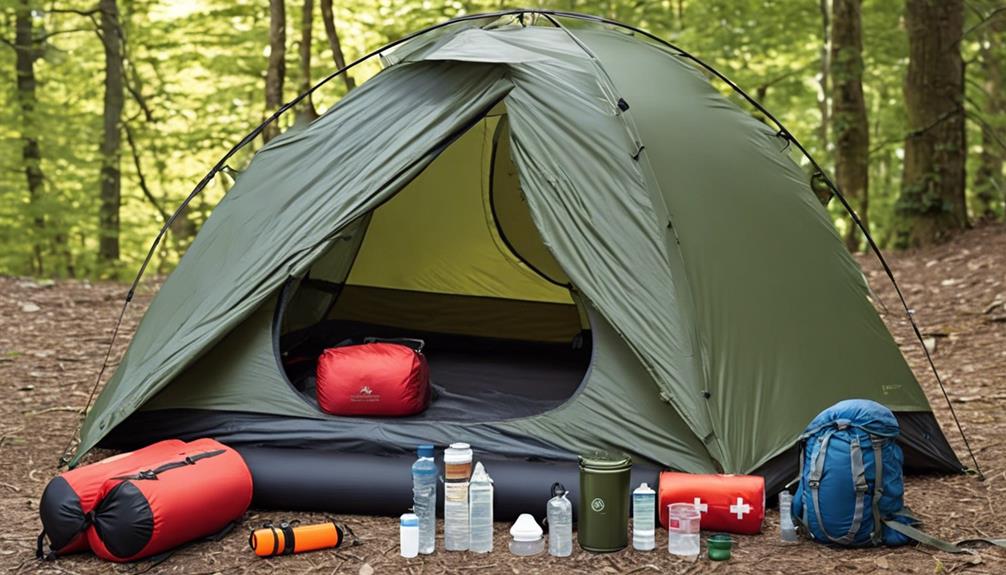With more than 46 million Americans engaging in camping activities each year, the popularity of solo camping is on the rise. Venturing into the wilderness alone can be a fulfilling adventure, but it necessitates thorough planning and preparation.
What are the key strategies solo campers should consider to ensure a successful and safe journey into nature's embrace?
Key Takeaways
- Prioritize safety, convenience, and amenities when selecting a campsite.
- Inform a trusted individual about your camping plans for safety.
- Pack essential gear like a quality tent and proper lighting tools.
- Regularly monitor weather conditions and be prepared for potential hazards.
Campsite Selection
When choosing a campsite for solo camping, prioritize safety, convenience, and amenities to enhance your overall experience. The campsite selection plays a crucial role in shaping your solo camping adventure.
Look for a campsite that offers proximity to other campers for safety and social interaction, especially if you're new to solo camping. Check for amenities such as bathrooms and cellphone service to stay connected and comfortable during your stay.
Ensure the campsite aligns with your preferred activities and interests to make the most of your time outdoors. Choosing a location near attractions like hiking trails or swimming spots adds convenience and opportunities for exploration.
Additionally, consider the level of comfort and safety the campsite provides to create a secure environment for your solo camping experience. By carefully selecting your campsite, you set the foundation for a fulfilling and enjoyable camping experience.
Essential Gear Checklist

Selecting the ideal campsite sets the stage for a successful solo camping adventure, and equipping yourself with the right gear is just as crucial for a safe and enjoyable experience in the great outdoors. When embarking on a solo camping trip, ensuring you have the essential gear can make all the difference. Here are three must-have items to include on your checklist:
- Quality Tent: A sturdy tent provides shelter and protection from the elements, creating a comfortable home base during your wilderness stay.
- Warm Sleeping Bag and Pad: A cozy sleeping bag and insulating pad are vital for a restful night's sleep, especially when temperatures fluctuate in the great outdoors.
- Cooking Equipment: Packing a camping stove and cooking utensils allows you to prepare hot meals and beverages with ease, adding a touch of comfort to your solo camping experience.
Safety Precautions

Ensuring your safety during solo camping adventures necessitates proactive preparation and mindful consideration of potential risks. Before embarking on a solo camping trip, it's crucial to check the weather forecast to anticipate any sudden changes in conditions. Packing enough food and water is essential for sustaining yourself throughout the journey. When facing wildlife encounters, staying calm and knowing how to react can lead to a safe and enjoyable trip. Acknowledge feelings of fear as a natural response to being alone in the wilderness, and use it as a motivator to stay cautious and alert.
Carrying communication tools like What3Words can provide precise location sharing with loved ones, adding an extra layer of safety. Informing a trusted individual about your solo camping plans ensures that someone is aware of your whereabouts in case of emergencies. Remember to carry a first aid kit and emergency supplies to handle any unforeseen situations that may arise. Avoid sharing detailed camping plans on public platforms to maintain online safety and privacy during your outdoor adventures. By following these essential tips, you can enjoy a secure and fulfilling solo camping experience.
Route Planning

For a successful solo camping trip, meticulous route planning is key to ensuring a safe and enjoyable outdoor adventure. When embarking on a solo camping adventure, here are three crucial aspects to consider for effective route planning:
- Research Landmarks: Familiarize yourself with the trails and landmarks in the area to avoid getting lost and navigate with confidence.
- Identify Obstacles: Take into account potential obstacles such as water crossings or steep climbs when planning your route to ensure a smooth journey.
- Prepare for Wildlife Encounters: Be mindful of the wildlife inhabiting the area and pack necessary deterrents like bear spray to stay safe during your solo camping expedition.
Weather Monitoring

When venturing into the wilderness for a solo camping expedition, vigilantly monitoring the weather becomes a vital component of ensuring a safe and successful outdoor experience. Make sure to regularly check weather conditions using reliable sources to make informed decisions about your outdoor activities.
Being aware of potential weather hazards such as thunderstorms, high winds, or extreme temperatures is crucial for your safety. Carry appropriate camping gear like rain gear, extra layers, and a sturdy tent to withstand different weather conditions you may encounter.
Stay informed about local weather patterns in the area where you're camping to better prepare yourself. Pay attention to any weather alerts or warnings that may affect your camping trip.
Frequently Asked Questions
How Do You Prepare for Solo Camping?
When preparing for solo camping, one should research the area, create a checklist, pack enough food and water, inform a trusted person, and carry navigation tools. These steps ensure a safe and enjoyable experience in the great outdoors.
How Do You Enjoy Camping Solo?
To enjoy camping solo, one must embrace the solitude and freedom it offers. Disconnect from distractions, immerse in nature, engage in activities that bring joy, and relish in self-reflection. It's a journey of personal growth and tranquility.
How Can a Woman Go Camping Alone?
For a woman to go camping alone, she should prioritize safety by choosing well-traveled locations, joining camping groups for support, and packing essential security items. Trusting intuition and honing outdoor skills will empower her to enjoy solo adventures confidently.
How Do You Tent Camp Like a Pro?
To tent camp like a pro, choose a high-quality, lightweight tent with proper ventilation. Practice setting it up beforehand, consider the weather and terrain, use a groundsheet, and secure with guy lines and stakes for stability in varying conditions.
Conclusion
As the sun sets on another day of solo camping, the sense of accomplishment and freedom washes over the tired but content camper.
The juxtaposition of solitude and connection to nature creates a unique experience that can only be truly appreciated by those who venture out alone.
With the right preparation and mindset, solo camping offers a chance to disconnect from the noise of everyday life and reconnect with the simplicity and beauty of the natural world.











